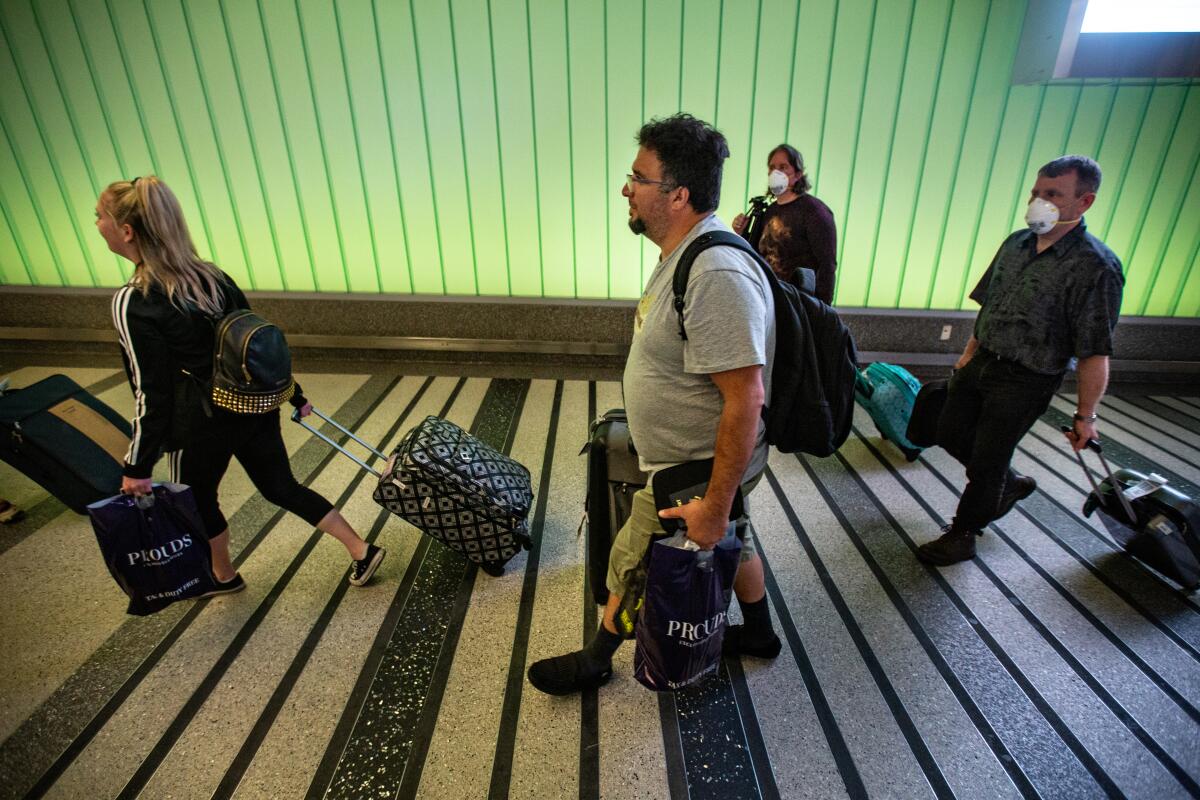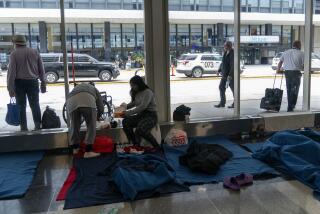For LAX passengers returning from Europe, it’s nothing like the chaos at other major airports

- Share via
Los Angeles resident Aidan Merryman heard about the long waits for American travelers returning from Europe and braced himself for something similar at Los Angeles International Airport.
But when the 23-year-old and his girlfriend arrived Sunday afternoon from Amsterdam, their experience was nothing like the chaos seen at airports in Chicago, Boston, Dallas and elsewhere. Problems around the country were blamed in large part on a combination of medical screenings and confusion over new international travel restrictions.
Merryman and his companion, who did not want to be identified, had their temperatures taken at U.S. customs with an infrared thermometer held near their foreheads. They were also asked about whether they had potentially interacted with someone who had the coronavirus and then were told to go home and self-quarantine for two weeks.
“They did ask several questions of if we knew anybody who had the coronavirus or had come into contact with someone who might have had it,” Merryman said. “That was probably the longest part.”
But the questioning, screening and checkout process lasted only 30 minutes, he said.
Unlike many travelers, Merryman and his girlfriend did not cut short or alter their plans but instead were at the scheduled end of a one-week vacation.
“I guess we were lucky,” he said.
Victorville resident Sharon Rankin, 64, who was also returning from Amsterdam, described the mostly trouble-free experience going through U.S. customs as a “welcome relief.”
“The whole process took maybe an hour,” Rankin said. “We landed here at 1 p.m. and went through customs and picked up our bags, and were ready right around 2 p.m.”
She had her temperature checked, filled out some paperwork and was given some information on what precautions to take, Rankin said.
“They gave us some pamphlets that said we were supposed to stay at home and quarantine for 14 days,” she said.
The 64-year-old was one of 19 members on a family trip that was planned to include two weeks traveling throughout Spain.
Instead, the trip lasted less than half as long as the Spanish government announced Saturday night that it was shutting down restaurants, museums, tourist locations and hotels, while forcing people to stay home as the country grapples with about 8,000 confirmed coronavirus infections and nearly 300 deaths. Like Italy and France, the country is essentially on lockdown.
“They were shutting down Barcelona by 8 p.m.,” said family traveler Jerry Borja, 45, also of Victorville. “It’s a major emergency in Spain, and they’re turning hotels into hospitals, so we got out.”
The family flew from Barcelona to Amsterdam before hopping on a 10 ½-hour flight to Los Angeles.
“There were like 80 of us, almost all Americans, on this big 747 [plane] from Amsterdam,” Borja said. “That was really nice.”
Not everyone’s experience through U.S. customs was pleasant Sunday, however.
Los Angeles native Matthew Paragas and a group of family members arrived early at the Tom Bradley International Terminal to await the arrival of his aunt Ada Butio, 61, from Manila.
Hours passed after the plane landed at 8:30 a.m. and nearly everyone onboard had disembarked, but Butio, who was traveling alone, still had not shown up.
“We had been waiting for maybe five or six hours and we didn’t know what was going on, so we went to the office to ask,” Paragas said.
Eventually, at 2:45 p.m., Butio was released, thanks to the help of another Philippine Airlines passenger who had stayed behind to serve as an interpreter.
“We found out that she almost got rejected and was about to be sent home,” Paragas said. “I know everyone is worried about the coronavirus, but she’s healthy and I’m just happy someone stayed behind to help translate.”
Family members said customs officials had crumpled and disregarded a letter Butio was carrying from USC Keck Hospital explaining that she was a potential kidney donor for her brother Bonnie Paragas.
“I find it very unnecessary how they treated the situation,” Matthew Paragas said. “They rejected her even though she had a letter stating that she was cleared to go from a doctor.”
Airport workers were also feeling the effects of the coronavirus outbreak.
On Sunday, officials announced that a police officer at LAX and two airport workers had tested positive for the virus that causes COVID-19. In San Jose, four Transportation Security Administration employees also tested positive, and San Francisco International Airport reported an Alaska Airlines customer service employee was infected.
Meanwhile, long lines, confusion and general chaos reigned at other airports around the country over the weekend.
Illinois Gov. J.B. Pritzker described a sense of alarm upon seeing images of travelers returning from Europe and elsewhere tightly packed for hours Saturday evening at Chicago’s O’Hare International Airport as they awaited screening. Similar scenes played out at other major airports.
“As people were flooding into O’Hare airport, they were stuck in a small area, hundreds and hundreds of people, and that’s exactly what you don’t want in this pandemic,” the governor said on NBC’s “Meet the Press.”
Pritzker predicted the chaotic conditions would persist throughout the weekend at least. “There are a larger number of flights with more people coming, and they seem completely unprepared,” he said in the interview.
Many travelers abroad had rushed to return in the mistaken belief that U.S. citizens risked being shut out by a ban on arrivals from much of Europe, effective Friday at midnight, that was announced last week in an Oval Office address by President Trump. The White House later clarified that the prohibition would not apply to U.S. citizens, their immediate family or permanent residents.
“They should have increased the Customs and Border Patrol numbers, and they should have increased the number of CDC personnel on the ground doing those checks,” Pritzker said. “They did neither of those.”
Chicago Mayor Lori Lightfoot called conditions at O’Hare and other airports “utterly unacceptable.”
Saying she was directly addressing her comments to Vice President Mike Pence and members of the federal coronavirus task force, she said, “You must listen to mayors and governors and other local officials first — bring us along on the journey.”
Criticizing the airport waits and overcrowding as creating precisely the conditions that would further spread the virus, Lightfoot warned, “Not only are you creating a disaster, not only are you creating a hazardous circumstance that threatens the public — you risk causing serious illness and death.”
Dr. Anthony Fauci, director of the National Institute of Allergy and Infectious Diseases, described the size and concentration of airport crowds as worrisome.
“We’d like to not see crowds like that,” Fauci, who is also part of the administration’s coronavirus task force, said on “Fox News Sunday.”
However, he was careful not to cast blame on the president’s Oval Office address, which set off a rush of travelers to European airports seeking U.S.-bound flights.
“I think people understand if you’re an American citizen, if you are a family member, that you can get back, you don’t need to rush back,” he said. “But it’s understandable if when people see a travel ban, they immediately want to … get home.”
Meanwhile, Trump tweeted Sunday about the long waits at airports.
“We are doing very precise Medical Screenings at our airports. Pardon the interruptions and delays, we are moving as quickly as possible, but it is very important that we be vigilant and careful. We must get it right. Safety first!”
More to Read
Sign up for Essential California
The most important California stories and recommendations in your inbox every morning.
You may occasionally receive promotional content from the Los Angeles Times.














